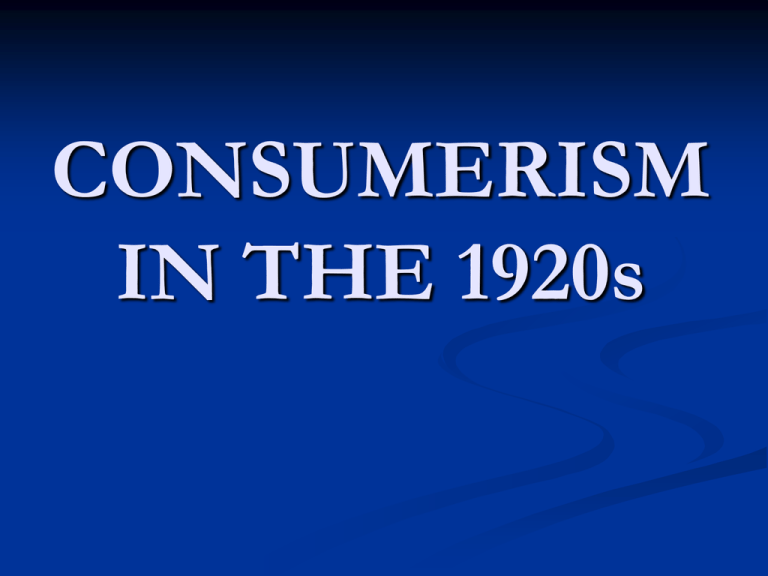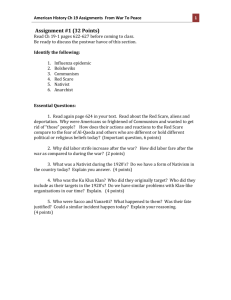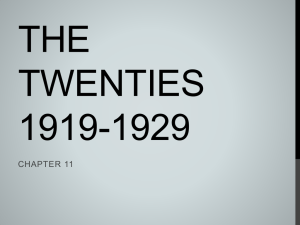The Business of America and the Consumer Economy in the 1920's
advertisement

CONSUMERISM IN THE 1920s Postwar Prosperity The "Second Industrial Revolution" : WWI stimulated development and investment in new technology that contributed to the business boom. As electricity became widespread and industrial production more efficient, mass produced consumer goods became available to the public at attainable prices (low). Consumers were reading many materials and purchasing the same goods. Communication innovations in radio, advertising, and film contributed to the homogenization of ideas that led to the advent of national popular culture. Postwar Prosperity The cycle that created the business boom in the 1920's: standardized mass production led to more efficient machines, which led to higher production and wages, which led to increased demand for consumer goods, which perpetuated more standardized mass production. Postwar Prosperity Industry *Percentage Increase, 1922-28 Industrial Production: 70% Gross National Product: 40% Per Capita Income: 30% Output per factory man hour: 75% Corporate Profits: 62% (1923-1929) Electric Power *Percentage Increase, 1899-1929: 331% Percentage of American Industries powered by electricity, 1929: 50% Workers *Percentage Increase, 1923-29 Worker's incomes: 11% Real Earnings (for employed wage earners) 22% Average Work Week: -4% In what general ways did the economy change in the 1920's? What changes in the average worker's wage, output, and work day length do you notice? Scientific Management and the Reorganization of Work Industries took a more organized and scientific approach under Taylorism. Industries began to employ automated machinery and "scientific management" to increase efficiency. The reorganization of work resulted in more spare time and disposable income for average workers. It also led to a decline in the importance of skill in favor of discipline and subordination. Businesses financed industrial research and time studies on a grand scale. The Principles of Scientific Management (1911) by engineer Frederick W. Taylor was widely published and applied - scientific management is also known as "Taylorism." Scientific Management and the Reorganization of Work Innovative industrialist Henry Ford masterfully applied Taylor's theory of worker efficiency and wage motive. Ford began paying an unprecedented $5 a day- it was more than a pay increase, it was a means for Ford to establish a measure of control over the workforce The price of Model-T was cut in half, thereby expanding the customer base. This image of a moving assembly line at Ford Motor Company demonstrates both the principles of efficient production and the proliferation of mass produced consumer goods. Scientific Management and the Reorganization of Work This article announces the clamor in Michigan after Ford began paying $5 a day. Scientific Management and the Reorganization of Work A furniture factory in 1903 A furniture factory in 1925 The Automobile and American Culture The explosive growth of the automobile industry revolutionized American life. Henry Ford's innovative production techniques made cars affordable for average Americans and set new standards for industry. By the end of the decade, there were enough cars on the road for every one in five persons. Related industries sprang up including service facilities, filling stations, and motels. General Motors Eclipses Ford The Model T Although Ford developed a system for mass-producing cars and selling them cheaply, Ford Motor Company failed to produce options for consumers. The utilitarian Model T was "available in any color, so long as it was black" and changed little in design over the years. When Alfred P. Sloan became president General Motors Corporation in 1923, he introduced alternative makes like Chevrolet and Buick that came in a variety of colors for increasingly sophisticated consumers. General Motors Eclipses Ford GM’s 1927 Cadillac La Salle- the first car designed by a stylist. Ford’s Model A GM tapped into the emerging consumer psychology, annually producing stylist updated models, marketing them aggressively, and promoting installment payment plans. Finally, in 1927, Ford Motor Company took a cue from GM's success and introduced the Model A with a blitz of advertising and the offer of installment plans. The product was so highly anticipated that many were sold before it was even introduced. Warren Harding and the “Return to Normalcy” Similar to modern Republicans in that they cut taxes to free up capital for investment and cut federal spending. President Warren Harding's campaign slogan, "Return to Normalcy," and his presidency itself were mediocre and uneventful, save for the scandals that came to light after his death in office. He took a laissez-faire stance in economics and government, so accordingly, he opposed organized labor and anti-trust measures. Warren Harding and the “Return to Normalcy” The influential Andrew Mellon on a postage stamp. Though he was an steadfast conservative, Harding took little initiative as a policymaker and delegated decision-making to a few key cabinet members. Secretary of the Treasury Andrew Mellon pushed through tax cuts to wealthy citizens and business, following the "trickle down" theory of economics. Secretary of Commerce Herbert Hoover and Secretary of State Charles Evans Hughes worked to secure foreign markets for American interests. Inaugural Address of Warren Harding (1921) “The forward course of the business cycle is unmistakable. … I speak for administrative efficiency, for lightened tax burdens, for sound commercial practices, for adequate credit facilities, … for the omission of unnecessary interference of Government with business, for an end to Government's experiment in business, and for more efficient business in Government administration. …” Protective Tariffs A protective tariff is a tax on imported goods to make the them less competitive with American-made goods. The Emergency Tariff Act of 1921 and the Fordney McCumber Act of 1922 imposed the highest tariff rates in history at the time. Lawmakers wanted to protect American interests as Europe began to recover and export its goods. The tariffs made it difficult for Europe to pay war debts and eventually slowed international trade by provoking other countries to enact high tariffs on U.S. exports. Silent Cal and the Business of America Coolidge, Mellon, and Hoover When President Harding died in office in August 1923, the famously laconic Calvin Coolidge assumed the presidency. Coolidge's laissez-faire policy - cutting taxes, reducing government spending, and imposing high tariffs on foreign goods. He and Mellon were intensely focused on managing the government and its budget in an organized, business-like manner. Coolidge's famous remark, "The business of America is business," characterized the pro-business, proconsumerism mentality of the Jazz Age. Inaugural Address of Calvin Coolidge (1925) “… unless we wish to hamper the people in their right to earn a living, we must have tax reform. The method of raising revenue ought not to impede the transaction of business; it ought to encourage it. I am opposed to extremely high rates, because they produce little or no revenue, because they are bad for the country, and, finally, because they are wrong. … This country believes in prosperity. It is absurd to suppose that it is envious of those who are already prosperous.” What does it mean to be American? Advertising in the 20s This ad uses a celebrity endorsement to glamorize smoking and exploits the image of the “new woman” of the 1920’s. Advertising techniques refined as the mutually supportive phenomena of mass production and mass media exploded into the American consciousness. Modern advertising, using popular culture and celebrities to fuel consumption, began to take shape. The array of new appliances and consumer goods available at a lower cost due fueled consumption. Businesses conquered the challenge of efficiently producing enough goods; now the focus was creating desire. Advertising in the 20s Another ad legitimizing desire; it associates the product with glamour and modernity Advertising in the 20s See this ad, buy the radio, hear more ads, buy more stuff! “Kiss Me with your Barbasol Face” Forever Young Americans and their waists… Mobile Advertising… President Coolidge on Advertising (1926) “It makes new thoughts, new desires, and new actions. ... It is the most potent influence in adopting and changing the habits and modes of life, affecting what we eat, what we wear, and the work and play of the whole Nation. …” “Mass production is only possible where there is mass demand. Mass demand has been created almost entirely through the development of advertising. …” “Advertising ministers to the spiritual side of trade. … It is all part of the greater work of regeneration and redemption of mankind.” And the Best part is, it won’t cost you anything… Buy Now Pay Later! Credit and the Consumer This ad characterizes credit as a prudent financial decision and a way to gain instant gratification. As consumerism became a hallmark of Modernism, the stigma of purchasing goods on "installment plans" faded. The automobile industry was one of the first to capitalize on the potential of consumer credit, but other industries quickly followed suit.







